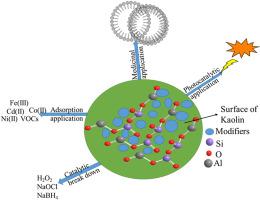纳米改性高岭土基材料及其应用综述
Q3 Materials Science
引用次数: 0
摘要
高岭土是一种天然粘土矿物,具有高岭石层和硅酸盐结构,具有高吸附性、低比表面积、优异的稳定性和环境友好性。这些特性使高岭石适用于广泛的应用。相反,有限的表面羟基、低离子交换能力和不能吸收可见光表明,纯高岭土或高岭石不是光催化的有效材料,在其他应用中表现不佳。幸运的是,高岭石独特的物理和化学性质使其成为合适的半导体载体。利用高岭土作为载体,可以解决纯光催化剂活性差、光谱响应窄、电子传递受限的问题,同时也限制了纳米颗粒的聚集。因此,使用纯高岭土/高岭土作为催化剂和吸附剂可以改善吸附和催化性能,现在使用了许多改性技术,如热处理(增加其表面积和孔隙度),酸改性(提高活性位点的可用性,以改善吸附和催化反应),金属改性(引入额外的活性位点),无机改性(提高热稳定性和光催化性能),和有机改性(增加疏水性)。本文综述了高岭石纳米复合材料在各种应用中的应用,包括吸附、光催化污染物降解、催化降解、抗菌和抗氧化活性。综述了纳米材料与天然高岭石或改性高岭石结合的有效性和方法,以及高岭石目前应用的局限性以及吸附、催化、光催化技术和污染物去除的机理。本文章由计算机程序翻译,如有差异,请以英文原文为准。

Nano modified kaolin-based materials and their application: A review
Kaolin, a natural clay mineral characterized by its kaolinite layers and silicate structure, exhibits high adsorbent properties, a low specific surface area, exceptional stability, and environmental friendliness. These attributes make kaolinite suitable for a wide range of applications. Conversely, the limited surface hydroxyl groups, low ion exchange capacity, and inability to absorb visible light indicate that pure kaolin or kaolinite is not an effective material for photocatalysis and performs inadequately in other applications. Fortunately, the unique physical and chemical properties of kaolinite render it as a suitable semiconductor carrier. By utilizing kaolin as a carrier, the poor activity, narrow spectral response, and limited electron transport of pure photocatalysts can be addressed, while also restricting the aggregation of nanoparticles. Thus, the usage of pure kaolin/kaolinite as a catalyst and adsorbent demonstrates to improve adsorption and catalytic performance, many modification techniques are now used, such as heat treatment (increases its surface area and porosity), acid modification (boosts the availability of active sites for improved adsorption and catalytic reactions), metal modification (introduces additional active sites), inorganic modification (improve thermal stability and photocatalytic performance), and organic modification (increase hydrophobicity). This review paper offers a structured overview of the use of kaolinite-supported nanocomposites across various applications, including adsorption, photocatalytic pollutant degradation, catalytic degradation, and antibacterial and antioxidant activities. The review also demonstrates the effectiveness and methods of combining nanomaterials with naturally occurring or modified kaolinite, as well as the limitations of kaolinite's present application and the mechanics underlying adsorption, catalytic, photocatalytic techniques and pollutant removal.
求助全文
通过发布文献求助,成功后即可免费获取论文全文。
去求助
来源期刊

JCIS open
Physical and Theoretical Chemistry, Colloid and Surface Chemistry, Surfaces, Coatings and Films
CiteScore
4.10
自引率
0.00%
发文量
0
审稿时长
36 days
 求助内容:
求助内容: 应助结果提醒方式:
应助结果提醒方式:


